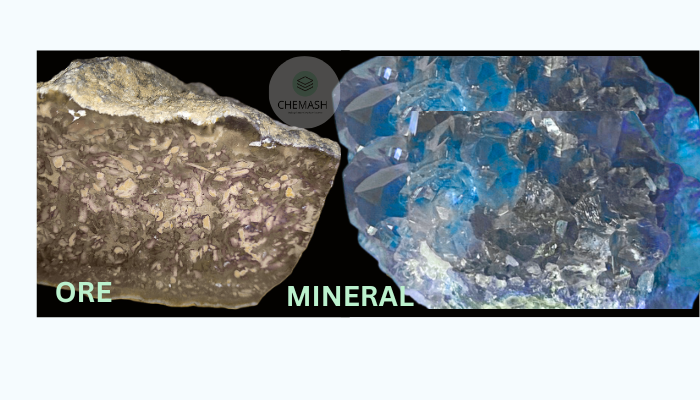
Minerals and Ores
Introduction
Minerals and Ores are fundamental components of the Earth’s crust. Minerals are naturally occurring, inorganic substances with a definite chemical composition and crystalline structure. Ores are minerals (or rock bodies) that contain metals in concentrations high enough to allow economical extraction.
Difference Between Minerals and Ores
| Minerals | Ores |
|---|---|
| Naturally occurring inorganic substances. | Minerals that contain metal in sufficient quantity for extraction. |
| May or may not contain metals. | Contain metals or metal compounds useful for extraction. |
| Used in construction, jewelry, industry, etc. | Primarily used for metal extraction and metallurgy. |
| Examples: Quartz, Calcite. | Examples: Hematite (Fe2O3), Bauxite (Al2O3·2H2O). |
Classification of Minerals
- Silicate minerals: Contain silicon and oxygen (e.g., Quartz, Feldspar).
- Non-silicate minerals: Do not contain silicon-oxygen frameworks (e.g., Calcite, Gypsum).
Types of Ores
Ores may be classified by the metal they yield or their origin:
- Metallic ores: Iron, Copper, Lead, Zinc, etc.
- Non-metallic ores: Industrial minerals like Salt, Gypsum.
- Primary ores: Large masses, comparatively unaltered.
- Secondary ores: Formed by weathering or supergene enrichment.
Extraction of Metals from Ores
The metal extraction workflow usually includes:
- Concentration: Remove gangue and impurities (e.g., froth flotation, magnetic separation, gravity separation).
- Reduction: Convert metal compounds to elemental metal (e.g., smelting in blast furnace, electrolytic reduction).
- Refining: Purify metal to required specification (electrorefining, zone refining for special metals).
Table: Common Ores and Their Metals
| Ore | Chemical Formula (typical) | Metal | Use / Notes |
|---|---|---|---|
| Hematite | Fe2O3 | Iron | Major iron ore; high iron content. |
| Magnetite | Fe3O4 | Iron | Magnetic; used in concentration by magnetic separation. |
| Bauxite | Al2O3·2H2O | Aluminium | Primary ore of aluminium; processed by Bayer & Hall–Héroult. |
| Galena | PbS | Lead | Primary ore of lead; often contains silver. |
| Chalcopyrite | CuFeS2 | Copper | Important copper ore, often processed by flotation and smelting. |
| Garnierite / Laterite | — | Nickel | Lateritic nickel ores common in tropical regions. |
Quiz: Test Your Knowledge
Short Answer
- Define a mineral and an ore.
- What is the main difference between a mineral and an ore?
- Name two metallic ores.
- What is the purpose of the concentration process in metal extraction?
- Give one example of a non-metallic mineral.
Answers & Explanations
- Answer: A mineral is a naturally occurring inorganic substance with a definite chemical composition and crystalline structure. An ore is a mineral (or rock) containing a metal in sufficient concentration to make extraction economical.
Explanation: Minerals are the broader category; ores are economically significant minerals or rocks. - Answer: Minerals may or may not contain metals; ores contain metals in extractable amounts.
Explanation: The word “ore” implies economic value for metal recovery. - Answer: Hematite, Bauxite.
Explanation: Hematite yields iron; bauxite yields aluminium. - Answer: To remove impurities (gangue) and increase the concentration of the metal-bearing mineral.
Explanation: Concentration improves efficiency of subsequent reduction/refining steps. - Answer: Quartz or Calcite.
Explanation: These are common non-metallic minerals used in many industries.
MCQs (choose the correct option) — With brief explanation
- Which of the following is an ore of iron?
a) Quartz
b) Hematite
c) Calcite
d) Gypsum
Explanation: Hematite is an iron oxide and a principal iron ore. - Ores are:
a) Always non-metallic minerals
b) Minerals with enough metal for profitable extraction
c) Inorganic substances with no metal
d) Organic compounds
Correct: b) Minerals with enough metal for profitable extraction.
Explanation: Ores must have economically extractable metal content. - Which process removes impurities from an ore?
a) Refining
b) Concentration
c) Smelting
d) Electrolysis
Explanation: Concentration removes gangue and raises ore grade before reduction. - Bauxite is the ore of:
a) Iron
b) Aluminium
c) Copper
d) Zinc
Explanation: Bauxite is the principal ore of aluminium (processed via Bayer + Hall–Héroult). - Minerals are:
a) Always metallic
b) Always man-made
c) Naturally occurring inorganic substances
d) Only found in ores
Correct: c) Naturally occurring inorganic substances.
Explanation: Minerals form naturally and are not man-made; not all are metals.
FAQ
What is the difference between ore and mineral?
A mineral is a naturally occurring inorganic substance with a fixed chemical structure. An ore is a mineral (or rock) from which metals can be extracted economically.
How is bauxite processed to produce aluminium?
Bauxite is processed by the Bayer process to produce alumina (Al2O3), which is then reduced to aluminium metal by the Hall–Héroult electrolytic process.
What are gangue and flux?
Gangue are the unwanted minerals in an ore. Flux is a substance (e.g., limestone, silica) added during smelting to combine with gangue and form a liquid slag that can be removed.
- USGS — United States Geological Survey
- Encyclopaedia Britannica — Ore
- More CHEMASH articles on Minerals
- Contact CHEMASH for content requests
Published: September 28, 2025
